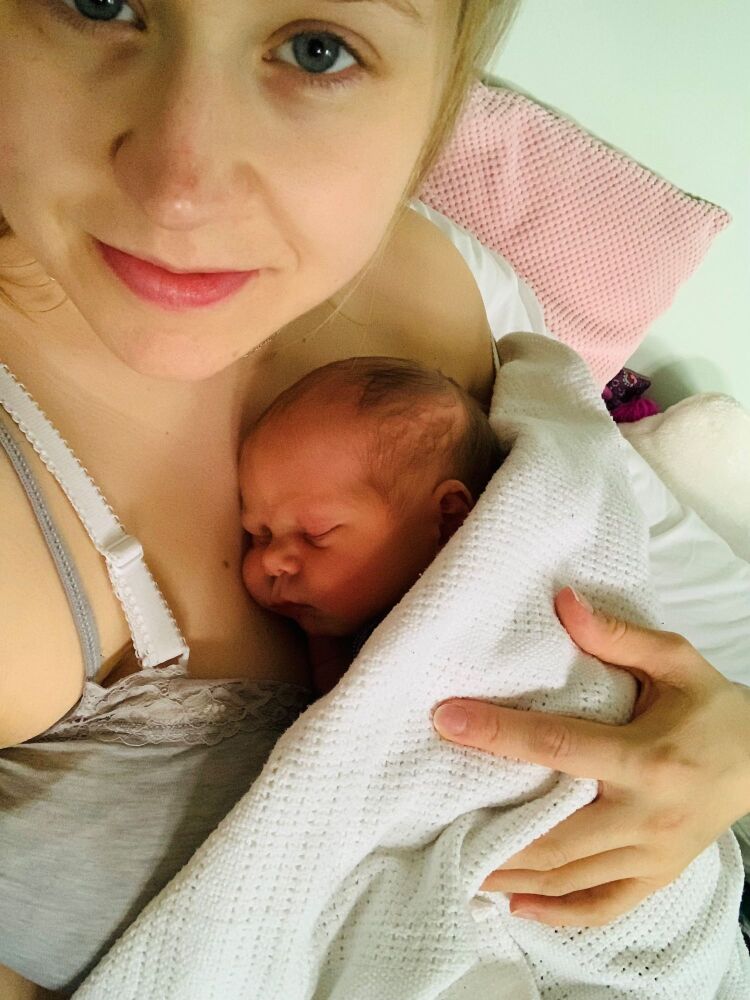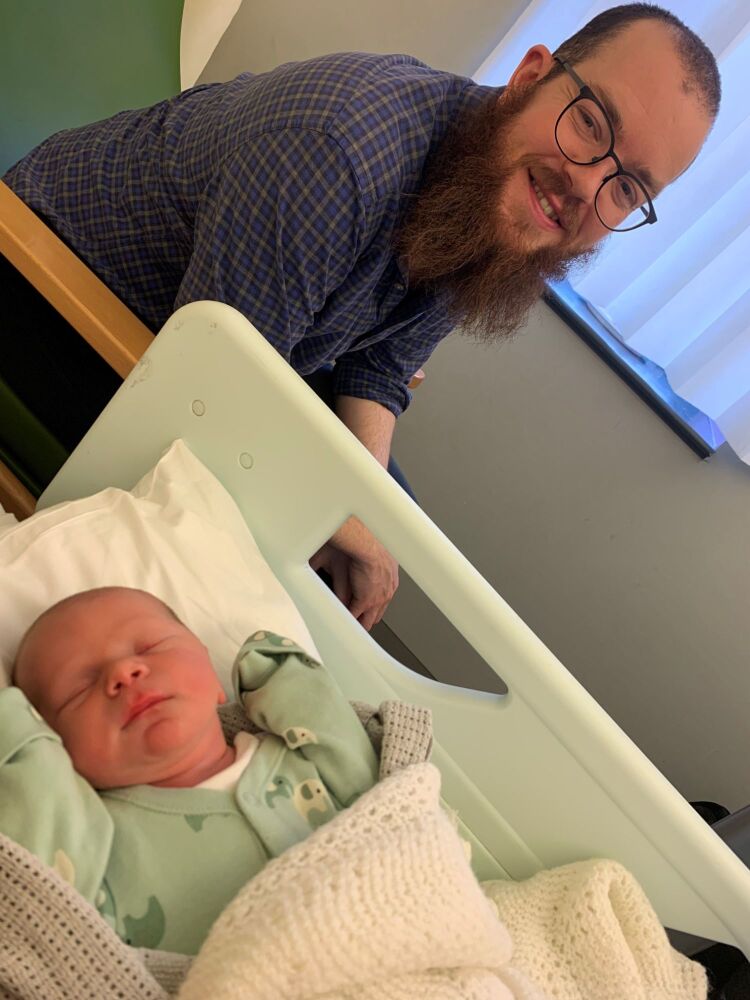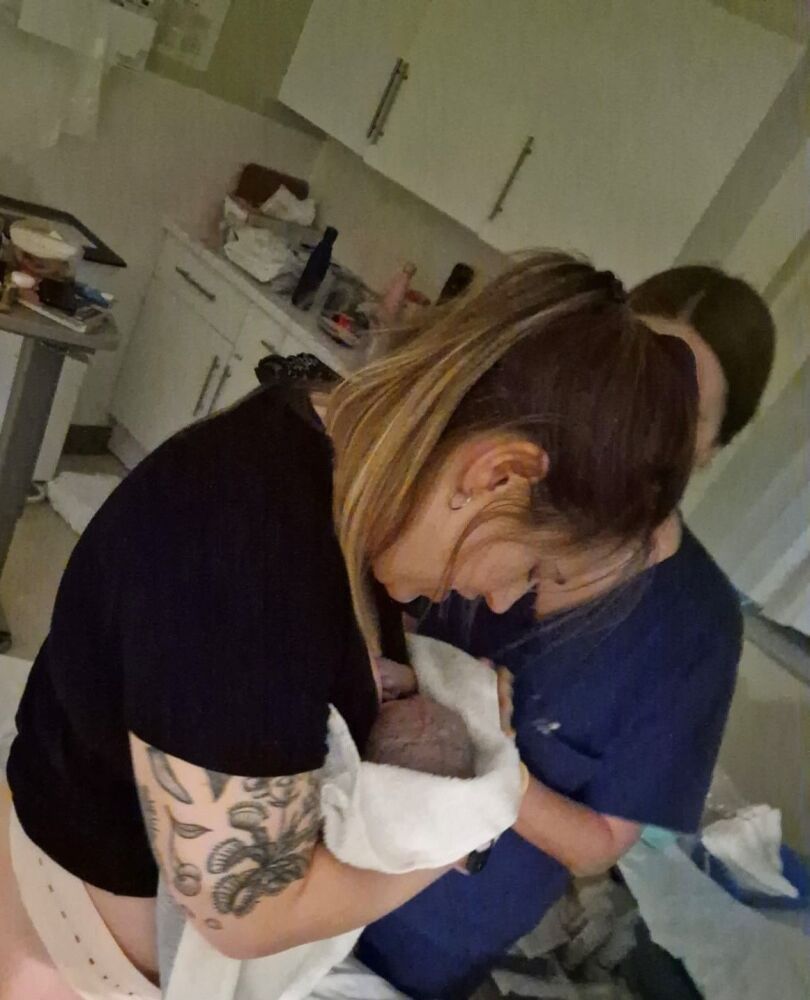Positive Induction at Queen Elizabeth Hospital after Pre-eclampsia and Breech Baby challenges
Posted on

For my first baby I’d taken a general antenatal class but unfortunately not had the birth experience that I’d wanted (baby 1 was taking his time at 42 weeks, and although I resisted repeated pressure to have an induction, I was refused entry to the birth centre because of his ‘overdue’ status and had a long labour ending in forceps in theatre and a very narrow miss of a c-section, followed by a postpartum haemorrhage (PPH) which meant I was put under general anaesthetic and kept in hospital for 5 days). Needless to say I was desperate to have a better experience for baby number 2!
My partner and I looked into hypnobirthing hoping to gain practical skills for coping with contractions, aiming to avoid interventions if we could. We learnt loads in Laura’s classes - and good thing too, as baby number 2 also decided to throw us a few curveballs! As a quick summary, my labour (on the Labour Ward of QE Hospital) was wonderful and straightforward; 8 hours with no tears and only gas and air. The run up to this however, was very stressful, and I hope my story will help anyone navigating a breech baby, preeclampsia or an induction of labour via Syntocinon drip.
After a very straightforward pregnancy, at 35+6 days I had my ‘36 week’ scan which showed baby as breech. A week later, in my routine midwife appointment, my blood pressure was suddenly measuring high - I think about 150/95. The midwife told me to go the Day Assessment Unit (DAU) immediately for monitoring. Remembering BRAINS, I asked what the risks of not going were. She said that I could be at risk of preeclampsia and therefore have a stroke. I didn’t feel that this was an immediate risk and said I’d swing by the Day Assessment unit the next day because I had a Birth Options appointment already and didn’t want to spend two consecutive days waiting around in the hospital. I went about my evening as normal, took my son to his swimming lesson and went to bed without issue. Despite my rising blood pressure I was completely free of symptoms of preeclampsia - I was determined not to panic and make any rash decisions until this changed (which it never did).
The next day I took my son to school and went to the gym as I always did. In my own time, I made my way to DAU ahead of my Birth Options meeting. I was really surprised when the midwife told me my blood pressure was still high. They recommended taking 100mg of Labetalol; a beta blocker. I barely take paracetamol and at first I refused. The midwife however said they couldn’t let me leave while my blood pressure was so high. She arranged for a doctor to come and explain the benefits and risks of the medicine. Seemingly the only risk of labetalol is that it can cause a dip in baby’s blood sugar after birth (and just to let you know this didn’t happen to my baby, even though by the end of the pregnancy I was on 900mg of Labetalol a day). I decided to take it. I had my urine checked for protein (there was none) and some blood work taken (all normal). After the Labetalol my blood pressure came down and I went to my Birth Options meeting with the consultant midwife Elaine at QE. I was told to come back to DAU for monitoring in two days.
While I was in DAU the doctor also mentioned the options around a breech birth and they gave me a leaflet on ECV. The doctor said that if it was successful, I could have an induction of labour (as they cannot induce a breech baby). I didn’t especially want an induction just because my blood pressure was high, but as we didn’t think there was anything to lose in trying to turn our breech baby, we decided to book in an ECV for the next day (more on this later).
The original purpose of the Birth Options meeting was to see if I could be allowed into the birth centre for baby number 2 following the PPH in my first birth. Unfortunately however, we now had a couple of other spanners in the works; baby was breech and my blood pressure was looking a little sketchy. I told Elaine that I really wanted to avoid a c-section at all costs and she referred me to another consultant midwife, Danielle, who I was told had experience in Vaginal Breech Births (VBB). I was really happily surprised that this could be an option at all! I’d heard that experience in this area had fallen and that the chance of getting a midwife who felt comfortable to do this was low.
The next day, we went to the Labour Ward for the ECV. I don’t know how else to say it, but it was the most excruciatingly painful procedure. I consider myself to have a high pain threshold and I was using my breathing techniques as best as I could, but even with gas and air I could not withstand the pain. After two intense attempts, baby had flipped back to his usual (flexed breech) position. I felt totally defeated! In the run up to the ECV I’d been practising the Spinning Babies techniques (Laura had mentioned these in one of the classes) of Forward Inversion and Breech Tilt. I was super active, walking for 2 hours every day and going to the gym 3 times a week. I felt I had done all I could to encourage baby to turn. I had tears in the skin of my bump from the ECV and as the days went on, my bruising got more and more severe. I honestly would not have it done again nor recommend it to anyone.
Choosing a Vaginal Breech Birth: Optibreech at Queen Elizabeth Hospital
The next day I was back in DAU, and my blood pressure was still high, so I was put on a prescription of Labetalol twice a day. I was told to come back every other day for monitoring. Alongside baby being breech, my hopes of getting to the birth centre were looking less and less likely. We were due to meet with Danielle (Consultant Midwife) in a few days and I went home and did as much research as I could around VBB. Some documents I found helpful were the Psychological Breech Birth Algorithm (https://www.kcl.ac.uk/news/new-algorithm-to-increase-breech-birth-safety) which shows the stages of intervention as well as Sara Wickham’s overview of the Term Breech Trial (https://www.sarawickham.com/questions-and-answers/what-was-the-canadian-term-breech-trial/). Over the weekend, Danielle also emailed information relating to the Optibreech method. QE & UHL were involved in an active Optibreech trial which hoped to provide more data around breech births - it was all sounding very promising!
On Monday we met Danielle. She was amazing from day one and completely alleviated all of my concerns around having a vaginal breech birth. My fears were largely centred around the one statistic from the Term Breech Trial which had shown that the rate of stillbirth increased from 0.05% in caesarean births to 0.2% in VBBs. I felt selfish that I was considering a more dangerous birth for my baby because I simply could not bear the thought of having a c-section. Danielle was extremely knowledgeable and pointed out several flaws in the Term Breech Trial (for example that one of the 0.2% babies had actually been a miscounted head-down baby). She said that if we went ahead, she would prepare a rota of midwives with breech training and/ or experience who would be on call for the next two weeks until I went into labour. Of these four/ five midwives, Danielle was the only one based at QE, the rest were at Lewisham (I’d had my first baby at Lewisham so this wasn’t a concern for me). I left the meeting feeling completely overjoyed that my hopes for a vaginal birth could still be possible. Danielle got to work preparing the rota and came to visit me whenever I was in DAU. I felt in very safe hands. I went home and had a bath listening to the Fear Release track. I envisioned myself having a successful vaginal breech birth.
A new challenge arises... Pre-eclampsia
Unfortunately, over the next week my blood pressure continued to climb and I was in DAU every day. My medication was increased from 100mg labetalol once a day to 300mg three times a day plus 20mg of nifedipine (a strong calcium channel blocker). Even despite all the medication my blood pressure continued to climb daily. Protein was eventually found in my urine and one of the senior obstetricians reviewed my blood work and diagnosed preeclampsia. She said that with my escalating blood pressure it was going from mild to moderate risk and heavily encouraged me to book an elective c-section. Given the known risks of preeclampsia, I begrudgingly agreed to a provisional c-section date. I honestly couldn’t believe my luck - I’d only just got myself into a positive mindset about having a breech birth and now I was being booked in for a c-section, the thing which I wanted least of all.
I hoped I’d go into natural labour but the c-section date quickly approached. I hardly slept the night before. I messaged Laura late into the night, telling her how much I didn’t want to go through with it. In a desperate moment I spoke to my baby and begged him to please help me out of this situation.
After a sleepless night, on the day of the c-section appointment, my partner called the labour ward and told them that I wasn’t coming for surgery, but that I would go to DAU for more monitoring. As soon as I arrived I burst into tears. The midwife on duty was very supportive and gave me a big hug, but there wasn’t much to do besides ask the doctor to come and review my seemingly limited options once again.
The obstetrician, Laurence, who I’d met a few times on DAU arrived. Seeing how upset I was, she offered to do a scan to see if baby was still breech. No one could believe it when, at 38+5 weeks, he was finally head down! I sobbed such happy tears. Honestly I was so familiar with the staff by this point that they all shared in my joy as well. They knew how much I wanted to avoid a c-section, and now I had the option to be induced and get the vaginal delivery that I wanted.
I was booked in that afternoon for an induction. We assumed that, with 1-2 pessaries, things wouldn’t really get going for another couple of days. However after a vaginal examination the doctor said they could break my waters (ARMS) that day and that no pessaries would be needed at all. They gave us a minute to think about it, and this is where my birth partner really stepped up. Using everything he had learnt in our hypnobirthing lessons, he said that he did not think going into labour that night was a good idea, seeing as we had had sleepless nights in the run up to the c-section appointment. He was completely right - we’d gone from a vaginal breech birth, to a planned c-section, to an induction in the space of a week. My original plan to give birth in the birth centre was out the window and I was exhausted. When the doctors came back, he told them we wouldn’t go through with the ARMS procedure tonight because we needed some rest. We agreed that I would spend the night in hospital and that we’d begin the induction in the morning.

The next morning however, there were not enough midwives on duty to facilitate an induction (since induction requires one-to-one midwife supervision due to the risks involved). By the evening, there were enough midwives, but not enough doctors. The obstetrician on duty told me I could go home and come back at 7am the next day. I asked him why I was being allowed home when up to this point my preeclampsia had been treated as extremely time sensitive. It was validating when he said that I seemed well and that he wasn’t worried as I was symptom free - this had been my gut feeling all along and the reason why I felt I could buy that little more time.
Starting the Induction
The next morning I had a cannula put in. Danielle popped by while we were waiting for a room on the Labour Ward (even though my baby was no longer breech, she continued to check on me up to and beyond the birth, which was so kind!). At 11am I had my waters broken (it wasn’t at all painful)and went for a long walk. Unfortunately nothing happened, so when we got back I asked to start the Syntocinon drip. At 3.30pm they started the drip on a low dose (0.3m/m), by 5.30pm they had upped it to 3.6m/m and I was having small period-like contractions which quickly became stronger. They turned the drip down to 2.4m/m and things slowed down. Although the drip means that it’s harder to mobilise, I remained upright doing a mix of bouncing on the birthing ball and swaying standing up. As things had started progressing, I asked the midwife if we could have a bit of privacy and she said she was happy to come back intermittently. By now evening was approaching and we asked to turn off the lights. We’d brought tea lights but the midwife showed us the heat lamp which emitted a warming light similar to the lamp at home. I felt calm, the surges were getting stronger but were completely manageable.
At 8pm there was a shift change and we were introduced to the lovely midwife Ilania. I was having regular contractions and I breathed (and bounced) through them. Ilania was just about to up the drip, since the CTG showed things had slowed down a little, but then all of a sudden things ramped up, and instead she turned the drip down. Up until this point I had been wired to both the drip as well as the CTG monitor, so I was relieved when the wireless monitor became free. It allowed me to mobilise even more and things continued to ramp up.
At 9pm I had an examination which showed I was only 2-3cm dilated. We assumed things would take a while longer, so at 10pm my birth partner took a nap. While he slept, I put my headphones in and listened to my motivational, high-energy tracks like Laura had suggested. I breathed through the contractions. As things ramped up, I used aromatherapy as a distraction. I had been sceptical of this initially, but had fallen in love with my bergamot and eucalyptus scented pebble from one of the hypnobirthing sessions! I used the rollerball given in our goody bags and doused the room with my fig room spray. The midwife returned and said how nice it smelled - as Laura had told us, they really have seen it all!
At 12am things had ramped up even more and I was losing focus. I woke up my partner and told him that I really needed him and that I thought that I might want an epidural. He suggested that I try the gas and air (which had been in my birth plan; I only wanted an epidural as a last resort). I knelt up on the bed, using the back of the bed for support, and he counted so that I could regulate my breathing on the gas and air. I continued to sway vigorously through the contractions (so much so that for days after I actually had motion sickness!). Swaying, breathing and counting got me through the contractions.
As 1am approached the midwife wanted to take my blood pressure readings but I couldn’t stay still enough to have it done. She also said it was becoming hard to get a consistent trace on the baby as I was moving around so vigorously and asked if we could use a Fetal Scalp Electrode (FSE) which I did not want. I said I was thinking about having an epidural and didn’t think the FSE was going to be necessary if that was the case. She suggested an internal exam but I didn’t think I could stay still enough. Eventually I agreed, but I said if I was any less than 8cm I wanted an epidural.
Fortunately, I was 8cm dilated! My birth partner told me that ‘this is why you’re feeling the way you are, you are so close now’, and I felt so much validation and relief that I felt able to carry on. By this point however, I was actually having a few too many (6/7) contractions per 10 minutes, which was putting stress on both my body and the baby. Ilania had turned the drip down but suggested also having an injection to stop the uterus contracting so much. My body had actually taken over the birthing process and I was able to come off the drip entirely, but I was still having too many contractions. The injection took the edge off and gave me a little more time to recover between them. I continued to sway, breathe and count through the intensity.
Suddenly the contractions eased off - I realised later that my body was giving me a break before the downstage commenced. I caught my breath and took the biggest swig of Lucozade (nearly the entire bottle!). I then started groaning and shouted to the midwife ‘I’M PUSHING!’. It was great that the urge to do this had come from my body; that it had known exactly what to do.
At 2am baby Shiloh’s head was out, and 1 minute later so was the rest of him! We had immediate skin to skin and my birth partner asked the midwife to tell him when the cord had gone white, which he then cut. My partner held the baby and I had active management for the placenta, which was delivered shortly after. The midwife was so thorough checking for any retained products to ensure I didn’t have another PPH. She really was excellent! She checked baby and then left us alone for some time.

At 4am we were moved to the postnatal ward and, having had no complications or tears, we were able to leave at 5pm that day. Even though I’d had an induction, it had been straightforward and everything had gone as well as it possibly could have.
I was so proud of myself - not just for the birth, but also for being brave enough to balance the need to get the baby out (because of preeclampsia) with waiting just that tiny bit longer. If I hadn’t, I might have had a c-section in week 38 and never got to see my breech baby turn. Clearly he just needed a bit more time! Next time, I’ll worry less over the baby’s position at 36 weeks and know that if they are breech, there’s a really good team of midwives at QE & Lewisham who can accommodate this.
I’ve also learnt that, even though preeclampsia can be extremely dangerous, it doesn't always mean there is an immediate need to take action. With regular monitoring it’s possible to review the situation day by day, which can be the difference between getting the birth you want or not.
Even though we had a lot thrown at us, in the end the decisions I made were right for me and I ended up having the most wonderful birthing experience.
Do you want a Positive Birth too?
My antenatal Hypnobirthing courses are available both in-person and online, and are designed to be a fun and relaxing experience for you and your birth partner - a real highlight of your pregnancy.
I offer different formats suitable for every budget as it is important that Hypnobirthing is accessible and affordable for everyone.
Find the perfect class for you:
- Private 1:1 Birth Coaching
- Group Hypnobirthing Courses (Abbey Wood, Bexley, Eltham, Sidcup, Woolwich & Greenwich)
Not sure which course is for you? Sign up to my next FREE Online Mini-Masterclass to start your journey to a glowing pregnancy, a positive birth, and the best possible start to parenthood!
